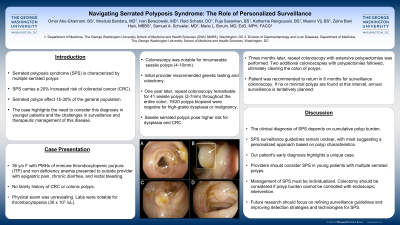Monday Poster Session
Category: Colorectal Cancer Prevention
P2162 - Navigating Serrated Polyposis Syndrome: The Role of Personalized Surveillance
Monday, October 28, 2024
10:30 AM - 4:00 PM ET
Location: Exhibit Hall E

Has Audio

Omar K. Abu-Ghannam, BS
George Washington University School of Medicine and Health Sciences
Washington, DC
Presenting Author(s)
Omar K. Abu-Ghannam, BS, Mrudula Bandaru, MD, Ivan Berezowski, MD, Reid Schalet, DO, Puja Sasankan, BS, Katherine Rangoussis, BS, MS, Maanvi Vij, BS, Zeina Bani Hani, MBBS, Samuel A.. Schueler, MD, Marie L.. Borum, MD, MPH, FACG
George Washington University School of Medicine and Health Sciences, Washington, DC
Introduction: Serrated polyposis syndrome is a rare condition estimated to occur in 1:100,000. The condition occurs equally in men and women at a mean age of ~55 years. The lifetime risk for colorectal cancer is estimated to be ~20%. Management strategies are not well defined. We report an unusual case of a woman diagnosed with serrated polyposis syndrome, expanding the recognition that this disorder can occur in young adults.
Case Description/Methods: A 37-year-old woman with immune thrombocytopenic purpura and iron deficiency anemia presented with rectal bleeding. Her exam was normal. An EGD was unremarkable. An initial colonoscopy revealed multiple sessile serrated polyps (4-10 mm) throughout her colon. She had no known family history of colon polyps or colon cancer. Genetic testing did not reveal a pathologic mutation. She was advised to undergo a colectomy, but opted to proceed with colonoscopies with polypectomies. A colonoscopy, performed 1 year after initial procedure, revealed 41 sessile polyps (2-7 mm). Twenty polyps were removed, of which 19 were sessile serrated adenomas without dysplasia or malignancy. She was diagnosed with serrated polyposis syndrome and has elected to continue colonoscopies with polyp removal. Subsequent surveillance colonoscopies are planned with effort to avoid a colectomy.
Discussion: The diagnosis of serrated polyposis syndrome is based upon the clinical criteria of >20 serrated lesions distributed throughout the colon with > 5 proximal to the rectum, or >5 serrated lesions proximal to the rectum, all >5-mm with at least 2 > 10 mm in size. Genetic testing is not recommended because associated mutations have not been definitively identified. Management is based upon number and size of serrated polyps and the presence of concurrent adenomas. Serial colonoscopies with polypectomies are recommended if resections can be adequately performed. If polyps are numerous, large or polyp growth cannot be endoscopically controlled, surgery is recommended. Subsequent surveillance colonoscopies should be performed every 1-3 years. Since there has been increased recognition that colon cancer is occurring at younger ages, this case is important because serrated polyposis syndrome is an under-recognized condition for which personalized management plans are necessary. It is crucial that we continue to recognize that sporadic, hereditary and rare conditions associated with colon cancer can occur in young adults.
Disclosures:
Omar K. Abu-Ghannam, BS, Mrudula Bandaru, MD, Ivan Berezowski, MD, Reid Schalet, DO, Puja Sasankan, BS, Katherine Rangoussis, BS, MS, Maanvi Vij, BS, Zeina Bani Hani, MBBS, Samuel A.. Schueler, MD, Marie L.. Borum, MD, MPH, FACG. P2162 - Navigating Serrated Polyposis Syndrome: The Role of Personalized Surveillance, ACG 2024 Annual Scientific Meeting Abstracts. Philadelphia, PA: American College of Gastroenterology.
George Washington University School of Medicine and Health Sciences, Washington, DC
Introduction: Serrated polyposis syndrome is a rare condition estimated to occur in 1:100,000. The condition occurs equally in men and women at a mean age of ~55 years. The lifetime risk for colorectal cancer is estimated to be ~20%. Management strategies are not well defined. We report an unusual case of a woman diagnosed with serrated polyposis syndrome, expanding the recognition that this disorder can occur in young adults.
Case Description/Methods: A 37-year-old woman with immune thrombocytopenic purpura and iron deficiency anemia presented with rectal bleeding. Her exam was normal. An EGD was unremarkable. An initial colonoscopy revealed multiple sessile serrated polyps (4-10 mm) throughout her colon. She had no known family history of colon polyps or colon cancer. Genetic testing did not reveal a pathologic mutation. She was advised to undergo a colectomy, but opted to proceed with colonoscopies with polypectomies. A colonoscopy, performed 1 year after initial procedure, revealed 41 sessile polyps (2-7 mm). Twenty polyps were removed, of which 19 were sessile serrated adenomas without dysplasia or malignancy. She was diagnosed with serrated polyposis syndrome and has elected to continue colonoscopies with polyp removal. Subsequent surveillance colonoscopies are planned with effort to avoid a colectomy.
Discussion: The diagnosis of serrated polyposis syndrome is based upon the clinical criteria of >20 serrated lesions distributed throughout the colon with > 5 proximal to the rectum, or >5 serrated lesions proximal to the rectum, all >5-mm with at least 2 > 10 mm in size. Genetic testing is not recommended because associated mutations have not been definitively identified. Management is based upon number and size of serrated polyps and the presence of concurrent adenomas. Serial colonoscopies with polypectomies are recommended if resections can be adequately performed. If polyps are numerous, large or polyp growth cannot be endoscopically controlled, surgery is recommended. Subsequent surveillance colonoscopies should be performed every 1-3 years. Since there has been increased recognition that colon cancer is occurring at younger ages, this case is important because serrated polyposis syndrome is an under-recognized condition for which personalized management plans are necessary. It is crucial that we continue to recognize that sporadic, hereditary and rare conditions associated with colon cancer can occur in young adults.
Disclosures:
Omar Abu-Ghannam indicated no relevant financial relationships.
Mrudula Bandaru indicated no relevant financial relationships.
Ivan Berezowski indicated no relevant financial relationships.
Reid Schalet indicated no relevant financial relationships.
Puja Sasankan indicated no relevant financial relationships.
Katherine Rangoussis indicated no relevant financial relationships.
Maanvi Vij indicated no relevant financial relationships.
Zeina Bani Hani indicated no relevant financial relationships.
Samuel Schueler indicated no relevant financial relationships.
Marie Borum: Takeda Pharmaceuticals – Consultant, Speakers Bureau.
Omar K. Abu-Ghannam, BS, Mrudula Bandaru, MD, Ivan Berezowski, MD, Reid Schalet, DO, Puja Sasankan, BS, Katherine Rangoussis, BS, MS, Maanvi Vij, BS, Zeina Bani Hani, MBBS, Samuel A.. Schueler, MD, Marie L.. Borum, MD, MPH, FACG. P2162 - Navigating Serrated Polyposis Syndrome: The Role of Personalized Surveillance, ACG 2024 Annual Scientific Meeting Abstracts. Philadelphia, PA: American College of Gastroenterology.
